Stability-Enhanced Emission Based on Biophotonic Crystals in Liquid Crystal Random Lasers
Abstract
:1. Introduction
2. Materials and Methods
3. Results and Discussion
4. Conclusions
Author Contributions
Funding
Institutional Review Board Statement
Informed Consent Statement
Data Availability Statement
Conflicts of Interest
References
- Rashidi, M.; Haggren, T.; Su, Z.; Jagadish, C.; Mokkapati, S.; Tan, H. Managing Resonant and Nonresonant Lasing Modes in GaAs Nanowire Random Lasers. Nano Lett. 2021, 2021, 3901–3907. [Google Scholar] [CrossRef] [PubMed]
- Consoli, A.; Caselli, N.; López, C. Electrically driven random lasing from a modified Fabry-Perot laser diode. Nat. Photon. 2021, 16, 219–225. [Google Scholar] [CrossRef]
- Liu, Y.; Yang, W.; Xiao, S.; Zhang, N.; Fan, Y.; Qu, G.; Song, Q. Surface-Emitting Perovskite Random Lasers for Speckle-Free Imaging. ACS Nano 2019, 13, 10653–10661. [Google Scholar] [CrossRef] [PubMed]
- Dogru-Yuksel, I.B.; Jeong, C.; Park, B.; Han, M.; Lee, J.S.; Kim, T.I.; Nizamoglu, S. Silk Nanocrack Origami for Controllable Random Lasers. Adv. Funct. Mater. 2021, 31, 2104914. [Google Scholar] [CrossRef]
- Ali, A.T.; Maryam, W.; Huang, Y.W.; Hsu, H.C.; Ahmed, N.M.; Zainal, N.; Jameel, M.S. SiO2 Capped-ZnO nanorods for enhanced random laser emission. Opt. Laser Technol. 2022, 147, 107633. [Google Scholar] [CrossRef]
- Xie, R.C.; Tsay, S.Y.; Wu, J.J.; Kuo, C.C.; Zhang, H.; Lin, J.H. Manipulation of plasmonic random laser from dye-doped liquid crystals inside photonic crystal fiber by the electric field. Opt. Laser Technol. 2022, 151, 108013. [Google Scholar] [CrossRef]
- Dai, G.; Wang, L.; Deng, L. Flexible random laser from dye doped stretchable polymer film containing nematic liquid crystal. Opt. Mater. Express 2020, 10, 68–75. [Google Scholar] [CrossRef]
- Biswas, S.; Kumbhakar, P. Continuous wave random lasing in naturally occurring biocompatible pigments and reduction of lasing threshold using triangular silver nanostructures as scattering media. Nanoscale 2017, 9, 18812–18818. [Google Scholar] [CrossRef] [Green Version]
- Meng, X.; Fujita, K.; Moriguchi, Y.; Zong, Y.; Tanaka, K. Metal-Dielectric Core-Shell Nanoparticles: Advanced Plasmonic Architectures Towards Multiple Control of Random Lasers. Adv. Opt. Mater. 2013, 1, 573–580. [Google Scholar] [CrossRef]
- Hsu, Y.; Tai, C.; Wu, H.; Hou, C.; Liao, Y.; Liao, W.; Haider, G.; Hsiao, Y.; Lee, C.; Chang, S.; et al. Self-Healing Nanophotonics: Robust and Soft Random Lasers. ACS Nano 2019, 13, 8977–8985. [Google Scholar] [CrossRef]
- Hu, H.; Haider, G.; Liao, Y.; Roy, P.K.; Ravindranath, R.; Chang, H.; Lu, C.; Tseng, C.; Lin, T.; Shih, W.; et al. Wrinkled 2D Materials: A Versatile Platform for Low-Threshold Stretchable Random Lasers. Adv. Mater. 2017, 29, 1703549. [Google Scholar] [CrossRef]
- Zhai, T.; Zhang, X.; Pang, Z.; Su, X.; Liu, H.; Feng, S.; Wang, L. Random Laser Based on Waveguided Plasmonic Gain Channels. Nano Lett. 2011, 11, 4295–4298. [Google Scholar] [CrossRef] [PubMed]
- Gummaluri, V.S.; Gayathri, R.; Vijayan, C.; Matham, M.V. Bio-inspired wrinkle microstructures for random lasing governed by surface roughness. Opt. Lett. 2021, 46, 1033–1036. [Google Scholar] [CrossRef] [PubMed]
- Mallick, S.P.; Hong, Y.H.; Chen, L.R.; Kao, T.S.; Lu, T.C. Effect of Passivation Layer on the Thin Film Perovskite Random Lasers. Materials 2020, 13, 2322. [Google Scholar] [CrossRef] [PubMed]
- Song, Q.; Xiao, S.; Xu, Z.; Liu, J.; Sun, X.; Drachev, V.; Shalaev, V.M.; Akkus, O.; Kim, Y.L. Random lasing in bone tissue. Opt. Lett. 2010, 35, 1425–1427. [Google Scholar] [CrossRef] [PubMed] [Green Version]
- Polson, R.C.; Vardeny, Z.V. Random lasing in human tissues. Appl. Phys. Lett. 2004, 85, 1289–1291. [Google Scholar] [CrossRef]
- Toffanin, S.; Kim, S.; Cavallini, S.; Natali, M.; Benfenati, V.; Amsden, J.J.; Kaplan, D.L.; Zamboni, R.; Muccini, M.; Omenetto, F.G. Low-threshold blue lasing from silk fibroin thin films. Appl. Phys. Lett. 2012, 101, 091110. [Google Scholar] [CrossRef]
- Da Silva, R.R.; Dominguez, C.T.; Dos Santos, M.V.; Barbosa-Silva, R.; Cavicchioli, M.; Christovan, L.M.; de Melo, L.S.A.; Gomes, A.S.L.; de Araujo, C.B.; Ribeiro, S.J.L. Silk fibroin biopolymer films as efficient hosts for DFB laser operation. J. Mater. Chem. C 2013, 1, 7181–7190. [Google Scholar] [CrossRef]
- Viola, I.; Ghofraniha, N.; Zacheo, A.; Arima, V.; Conti, C.; Gigli, G. Random laser emission from a paper-based device. J. Mater. Chem. C 2013, 1, 8128–8133. [Google Scholar] [CrossRef]
- Chen, Y.C.; Wang, C.S.; Chang, T.Y.; Lin, T.Y.; Lin, H.M.; Chen, Y.F. Ultraviolet and visible random lasers assisted by diatom frustules. Opt. Express 2015, 23, 16224–16231. [Google Scholar] [CrossRef]
- Wu, X.; Chen, Q.; Sun, Y.; Fan, X. Bio-inspired optofluidic lasers with luciferin. Appl. Phys. Lett. 2013, 102, 203706. [Google Scholar] [CrossRef]
- Sun, T.; Wang, C.; Liao, C.; Lin, S.; Perumal, P.; Chiang, C.; Chen, Y. Stretchable Random Lasers with Tunable Coherent Loops. ACS Nano 2015, 9, 12436–12441. [Google Scholar] [CrossRef] [PubMed]
- Sharma, A.; Goswami, K.; Mondal, H.; Datta, T.; Sen, M. A review on photonic crystal based all-optical logic decoder: Linear and nonlinear perspectives. Opt. Quant. Eelctron. 2022, 54, 1–24. [Google Scholar]
- Goswami, K.; Mondal, H.; Sen, M.; Sharma, A. Design and Analysis of All-Optical Isolator Based on Linear Photonic Crystal. Braz. J. Phys. 2022, 52, 1–10. [Google Scholar] [CrossRef]
- Mondal, H.; Sen, M.; Goswami, K. Design and analysis of all-optical 1-to-2 line decoder based on linear photonic crystal. IET Optoelectron 2019, 13, 191–195. [Google Scholar] [CrossRef]
- Stavenga, D.G.; Giraldo, M.A.; Leertouwer, H.L. Butterfly wing colors: Glass scales of Graphium sarpedon cause polarized iridescence and enhance blue/green pigment coloration of the wing membrane. J. Exp. Biol. 2010, 213, 1731–1739. [Google Scholar] [CrossRef] [Green Version]
- Zhang, D.; Kostovski, G.; Karnutsch, C.; Mitchell, A. Random lasing from dye doped polymer within biological source scatters: The pomponia imperatorial cicada wing random nanostructures. Org. Electron. 2012, 13, 2342–2345. [Google Scholar] [CrossRef]
- Zhang, H.; Feng, G.; Wang, S.; Yang, C.; Yin, J.; Zhou, S. Coherent random lasing from liquid waveguide gain channels with biological scatters. Appl. Phys. Lett. 2014, 105, 253702. [Google Scholar] [CrossRef]
- Wang, C.; Chang, T.; Lin, T.; Chen, Y. Biologically inspired flexible quasi-single-mode random laser: An integration of Pieris canidia butterfly wing and semiconductors. Sci. Rep. 2014, 4, 6736. [Google Scholar] [CrossRef] [Green Version]
- Chen, S.W.; Lu, J.Y.; Hung, B.Y.; Chiesa, M.; Tung, P.H.; Lin, J.H.; Yang, T.C.K. Random Lasers from Photonic Crystal Wings of Butterfly and Moth for Speckle-Free Imaging. Opt. Express 2021, 29, 2065–2076. [Google Scholar] [CrossRef]
- Ye, L.; Liu, B.; Li, F.; Feng, Y.; Cui, Y.; Lu, Y. The influence of Ag nanoparticles on random laser from dye-doped nematic liquid crystals. Laser Phys. Lett. 2016, 13, 105001. [Google Scholar] [CrossRef]
- Vollmer, F.; Arnold, S.; Keng, D. Single virus detection from the reactive shift of a whispering-gallery mode. Proc. Natl Acad. Sci. USA 2008, 105, 20701–20704. [Google Scholar] [CrossRef] [PubMed] [Green Version]
- Shang, Z.; Deng, L.; An, Y. Influence of fiber and MnCl2 on mode and threshold of random lasing in random gain systems. Opt. Express 2017, 25, 32522–32531. [Google Scholar] [CrossRef]
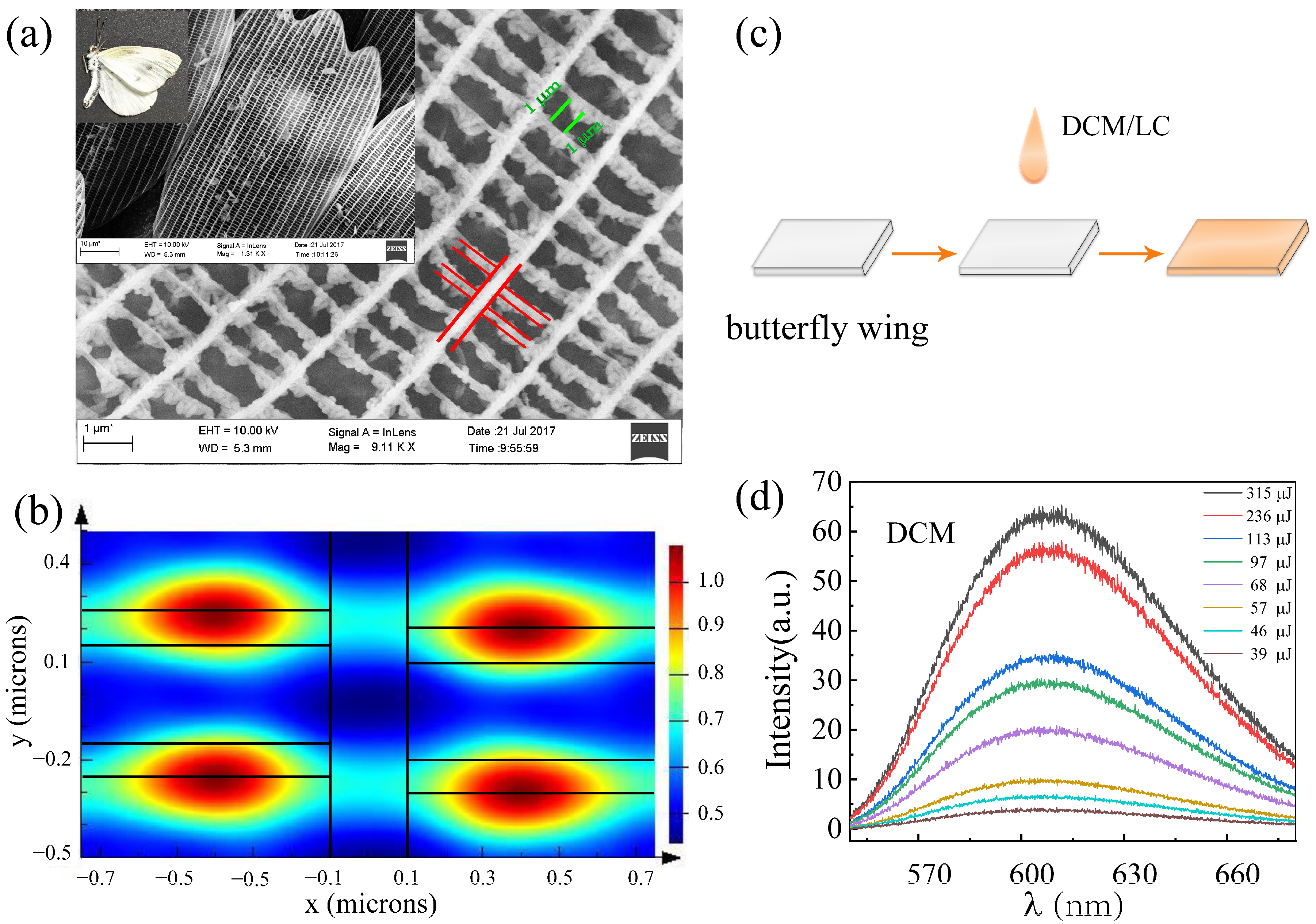
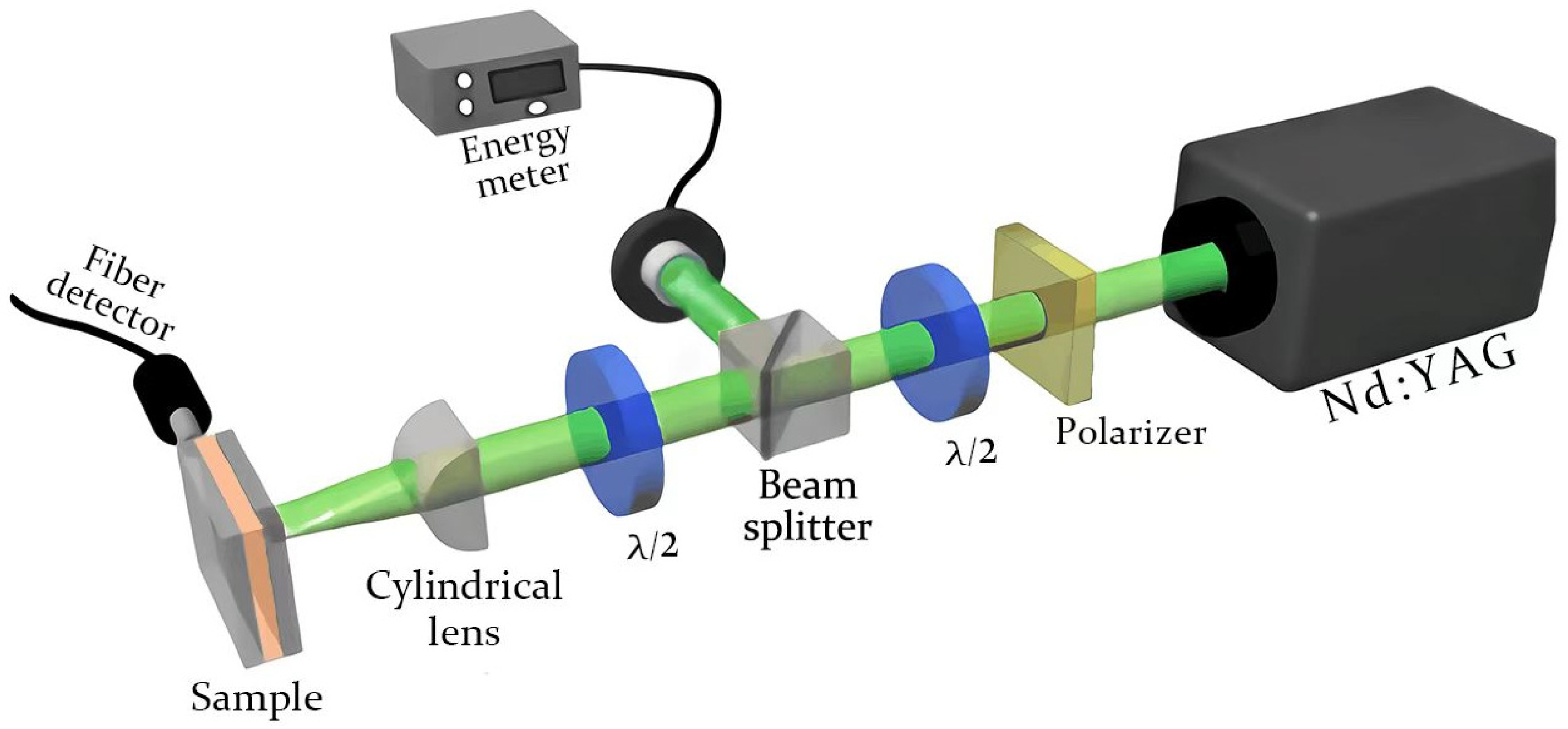
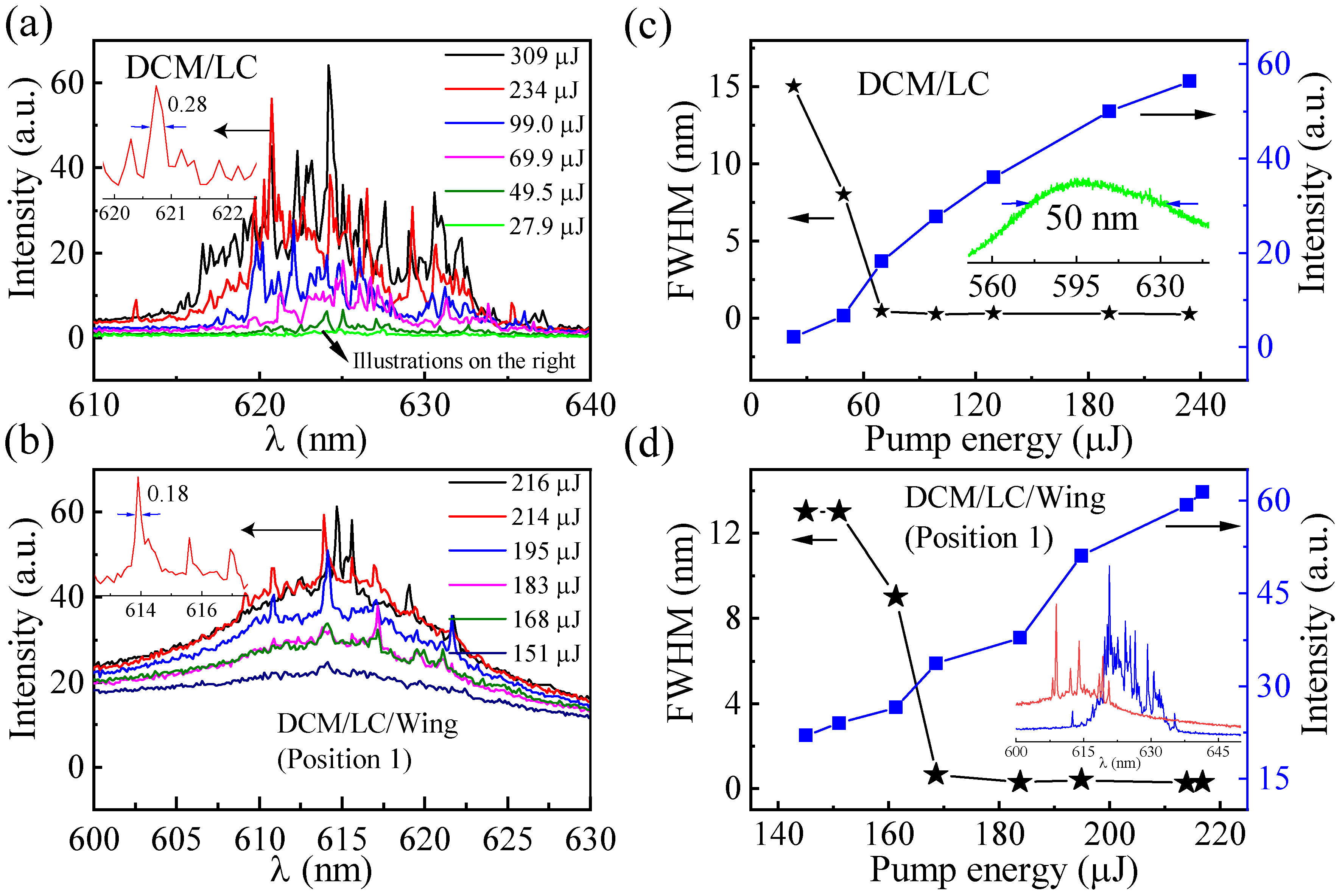

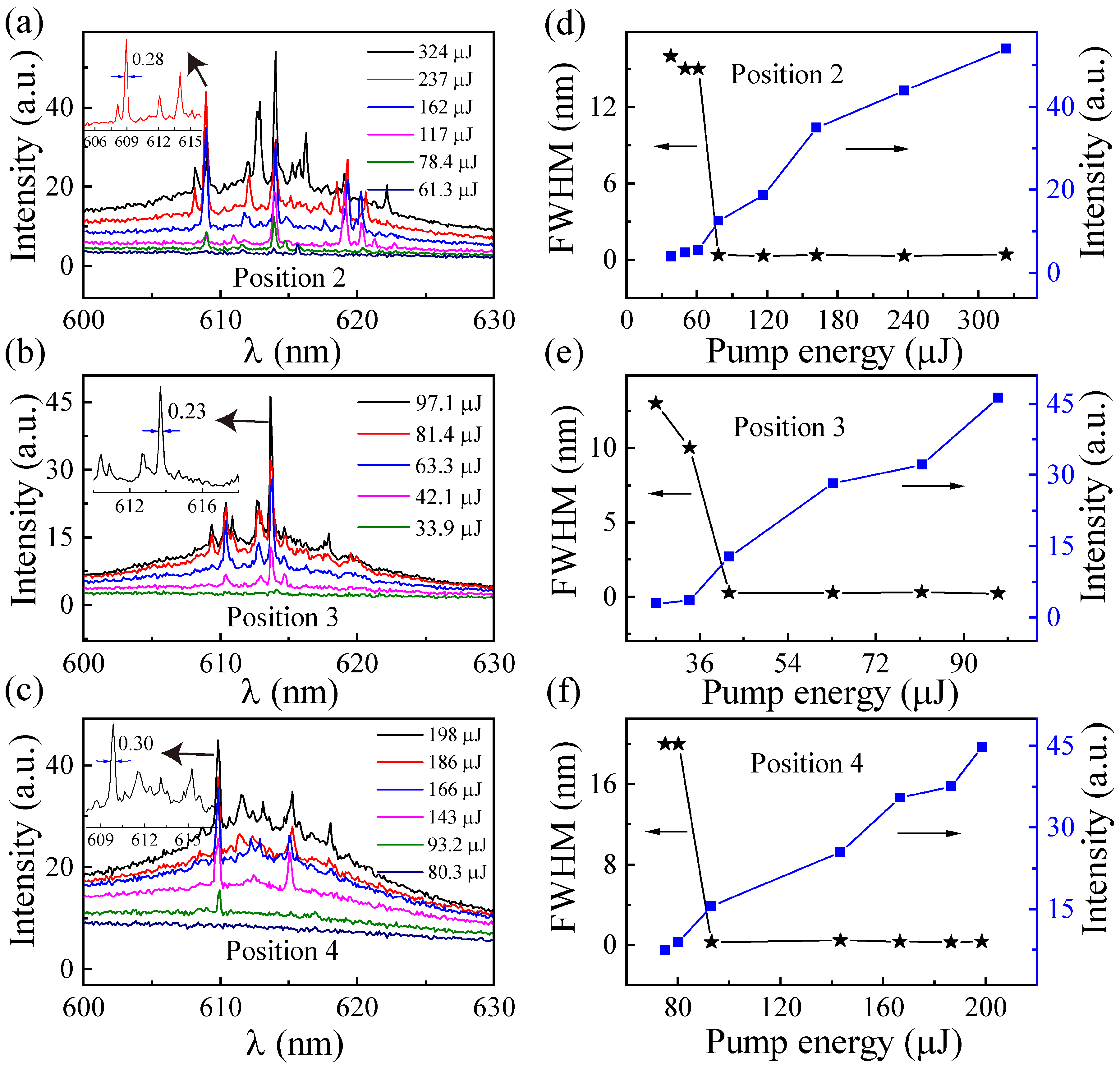


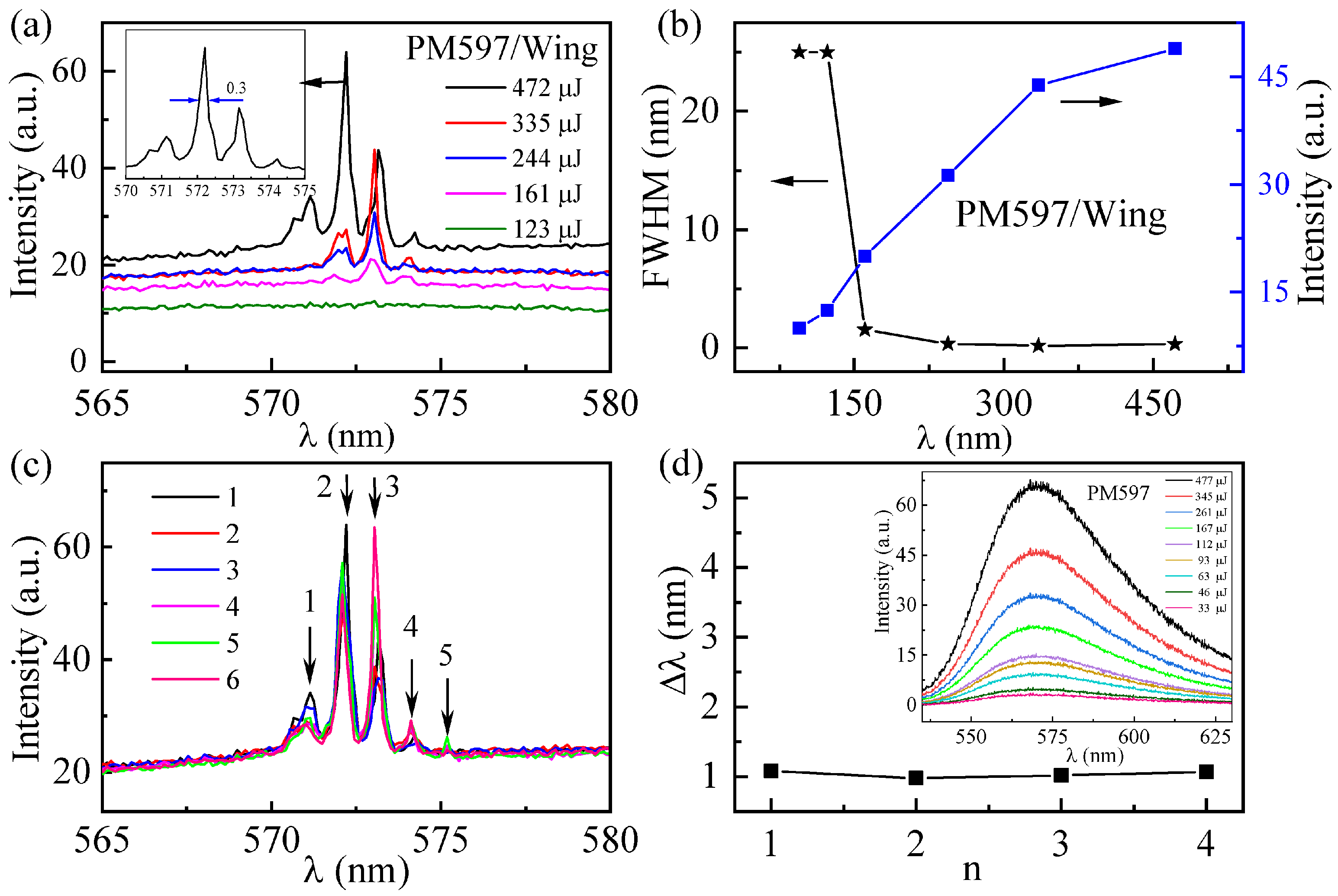
| Sample | Type | DCM (mL) | PM597 (mL) | Liquid Crystal (mL) | Capillary Glass (5 × 50 mm) | Glass Substrate (2 × 2 cm) |
|---|---|---|---|---|---|---|
| DCM/LC | - | 0.2 | - | 1 | 1 | - |
| DCM/LC/Wing | Wing | 0.2 | - | 1 | - | 1 |
| PM597/Wing | Powder | 1 | - | - | - |
Disclaimer/Publisher’s Note: The statements, opinions and data contained in all publications are solely those of the individual author(s) and contributor(s) and not of MDPI and/or the editor(s). MDPI and/or the editor(s) disclaim responsibility for any injury to people or property resulting from any ideas, methods, instructions or products referred to in the content. |
© 2022 by the authors. Licensee MDPI, Basel, Switzerland. This article is an open access article distributed under the terms and conditions of the Creative Commons Attribution (CC BY) license (https://creativecommons.org/licenses/by/4.0/).
Share and Cite
Shang, Z.; Wang, Z.; Dai, G. Stability-Enhanced Emission Based on Biophotonic Crystals in Liquid Crystal Random Lasers. Materials 2023, 16, 200. https://doi.org/10.3390/ma16010200
Shang Z, Wang Z, Dai G. Stability-Enhanced Emission Based on Biophotonic Crystals in Liquid Crystal Random Lasers. Materials. 2023; 16(1):200. https://doi.org/10.3390/ma16010200
Chicago/Turabian StyleShang, Zhenzhen, Zhi Wang, and Guang Dai. 2023. "Stability-Enhanced Emission Based on Biophotonic Crystals in Liquid Crystal Random Lasers" Materials 16, no. 1: 200. https://doi.org/10.3390/ma16010200




